What Does The 🤗 Hugging Face Emoji Mean? [Emojiology]
![What Does The 🤗 Hugging Face Emoji Mean? [Emojiology]](/content/images/size/w2000/2019/07/Emoji-Header-Hugging-Face-Emojipedia.jpg)
Among the newest members in the ever-growing emoji family in 2019 is Yawning Face, which is covering its mouth with a hand. This hand is notable not only because the gesture is central to depicting the act of a yawn and the tiredness or boredom the emoji is meant to convey, but also because that hand brings Yawning Face into a select cohort: smileys with hands.
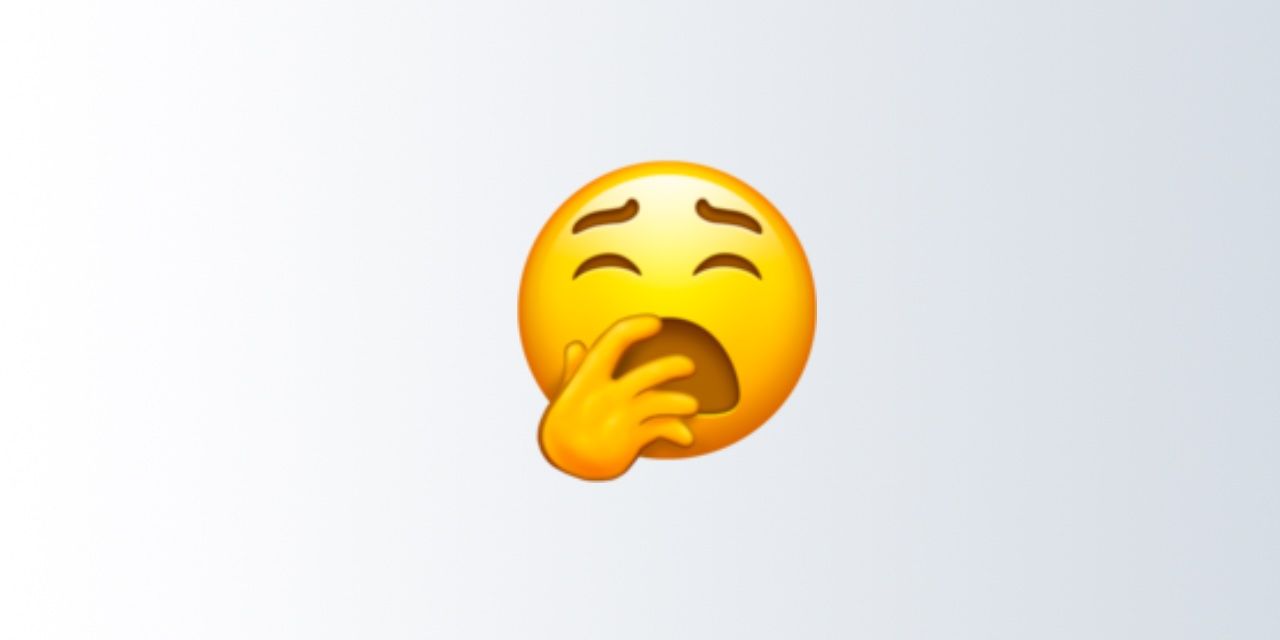
Of the more than 100 emojis classified as smileys, most are yellow, cartoon-styled faces with different expressions that communicate various feelings or ideas. A few have props, e.g., 🤠 Cowboy Face, and with the addition of Yawning Face, five now have hands.
🤫 Shushing Face is lifting a finger to its lips with a silencing “Shh!” of a librarian or a divulging “Can you keep a secret?” of a confidant. 🤭 Face With Hand Over Mouth is shielding a gasping “Oh my!” or coy “Oops!” while 🤔 Thinking Face is scratching its chin deep in thought or in a drawn-out, skeptical “Hmm…”
And then there’s 🤗, which surprises many when they learn it’s officially named Hugging Face. What are those hands up to, exactly? Are they offering a hug? Are they doing jazz hands? Are they trying to grab you? Those ambiguous hands are what we’re up to in this Emojiology.
🚨 Update March 2020: an new 🫂 People Hugging emoji was approved as part of Emoji 13.0, displaying two nondescript individuals sharing an embrace.
🔤 Meaning
🤗 Hugging Face features a warm smile and, on most platforms, hands with its palms facing out, intended to depict the act of hugging. As such, the emoji can express thanks, support, love, care, and other positive, affectionate feelings.
On many platforms, the splayed or outspread appearance of its hands resemble what is popularly taken as jazz hands. In this interpretation, 🤗 Hugging Face can indicate such feelings as excitement, enthusiasm, or a sense of flourish or accomplishment.
📜 A Brief History of Digital Hugs
🤗 Hugging Face was approved under Unicode 8.0 in 2015, but one of the earliest implementations of a hugging pictograph was on Microsoft’s MSN Messenger. This beloved instant messaging client was launched 20 years ago this July and entertained many an online chatter until its plug was pulled in 2014.
MSN Messenger offered many innovations over its long run, including, especially in its 6.0 update in 2003, emoticons. When a user typed a text-based emoticon, MSN Messenger converted it into an emoji-like icon, just as punching out a :) on many apps becomes 🙂 Slightly Smiling Face today.
MSN Messenger supported two hugging emoticons. The input for left hug was ({), whose curly open bracket {—also called a brace, evocatively enough for our purposes here—is a clever and efficient way to depict a person giving a hug from the left. (We can find <0>, (()), and o()o, among others, as other typographical hugs online as early as 1995). MSN Messenger rendered left hug ({) as a White man in a green top with his arms circling out from the left. One can complete the embrace with the closed curly bracket of right hug, (}), which turned into a Black woman in a blue top, her arms circling from the right.
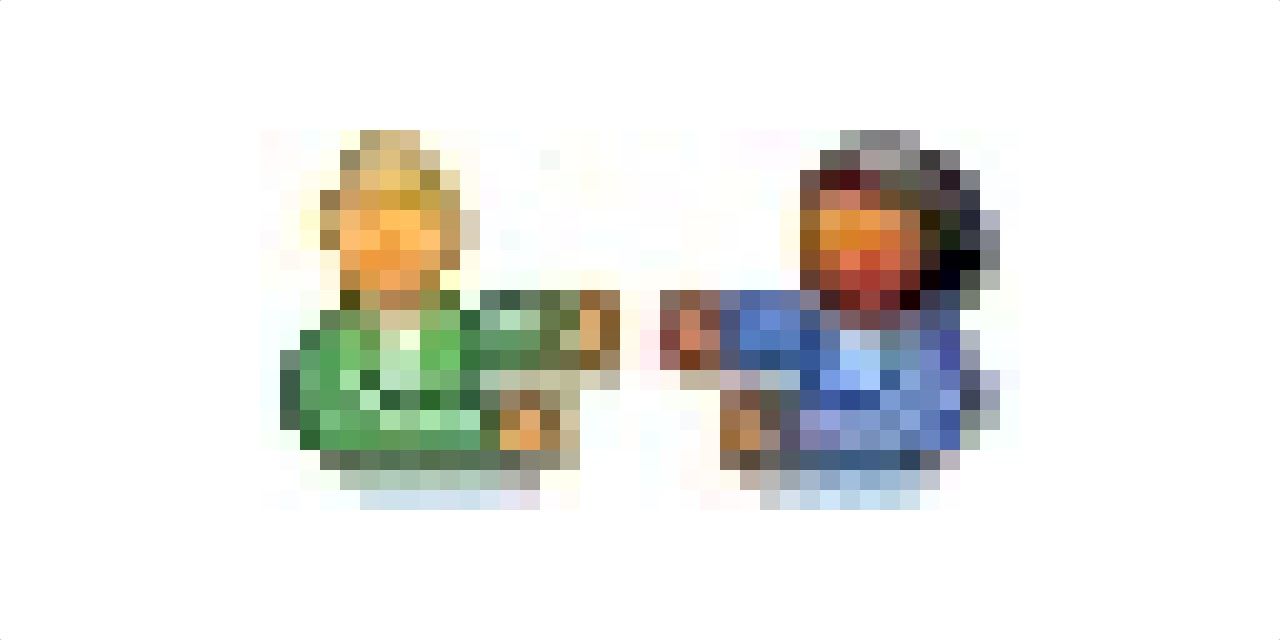
That MSN Messenger’s hugs are directionally gendered and racialized seems odd and unnecessary today, but the fact of that directionality is quite elegant. One can send out a left hug to another, who can reciprocate it with a right hug, a kind of enactment of a hug over the interwebs.
Another notable early e-hug came from Google, who introduced nearly 80 block-shaped, emoji-like characters on Gmail in October 2008. Among them, as we saw in our last Emojiology, was 🙃 Upside-Down Face. The set also included a charming animated pair—a touching, three-part tale, really, of a hug.

Act I. A yellow smiley, with a blank, if not glum expression, stares ahead on the left. Facing it on its right is a companion who, with a cheery grin and extended nubs for arms, sees that its pal could use a hug.
Act II. The sensitive hugger slides left and folds its downcast friend into its arms, its grin spreading and eyes closing into a bigger smile.
Act III. Upon contact, the hug-ee first flashes the surprise of an “Ooh! I didn’t know I needed a hug!” before waving its own nubby arms with a beaming smile, as if celebrating: “Woo-hoo! Yeah, I definitely needed a hug!”
Gmail’s emojis were largely based on early sets from the Japanese cell phone carrier au by KDDI, and records of Gmail’s initial emoji support in Japan link 🤗 Hugging Face to a Japanese emoticon (kaomoji): \(^-^)/.
A face with smiling eyes and extended arms, this hugging kaomoji anticipates 🤗 Hugging Face (in both form and sense of excitement) as it was implemented in Unicode 6.0 in 2015—and this makes Gmail’s animated hug a true original. Indeed, most of Gmail’s emojis (66 of 79) were mapped directly onto Unicode 6.0 in 2010, which exported emoji from Japan to the rest of the world. Gmail’s hug was not. The embracers were not immediately embraced into the standard.
🙋 Challenges with 🤗 Hugging Face
The great virtue of MSN Messenger and Gmail’s 🤗 Hugging Face predecessors is the obvious one: it takes two to hug. For a hug, in its most common definition, involves clasping someone else tightly in one’s arms.
In its current form, 🤗 Hugging Face only tells half the story of a hug. But, on many platforms, it tells it resourcefully, as many designs implement the same, rosy face as their 😊 Smiling Face With Smiling Eyes and hands similar to their 👐 Open Hands.
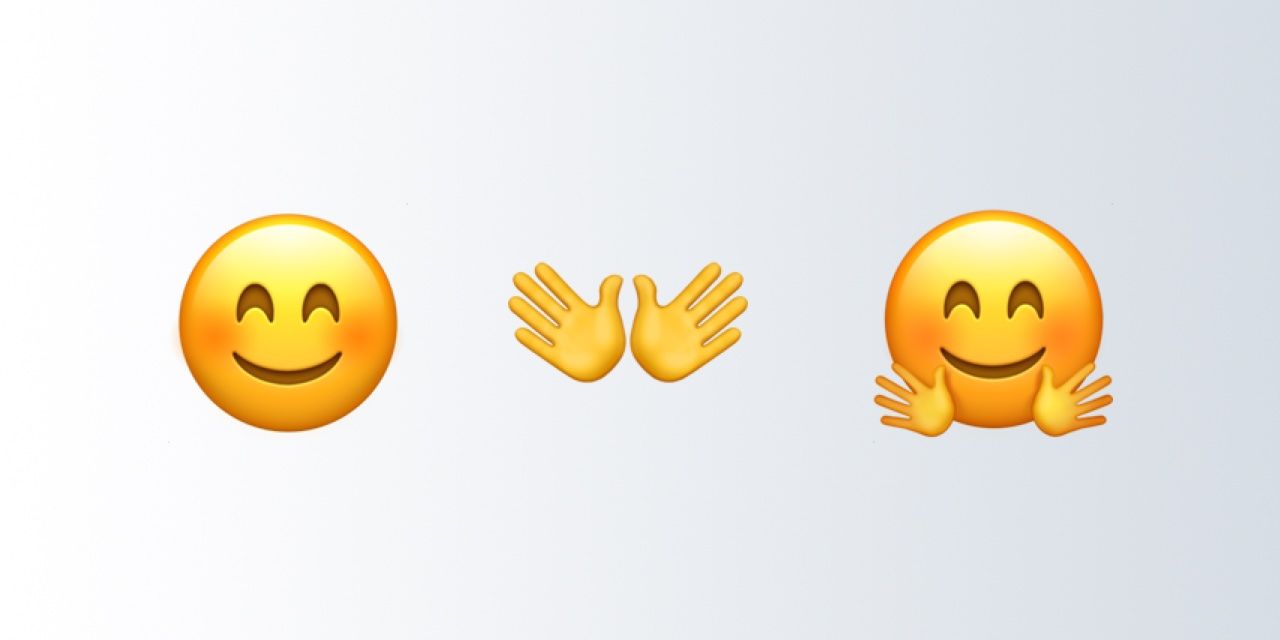
The major exception is Facebook, whose hands bear Mickey Mouse-esque white gloves, as is true of its other smileys with hands. Those hands are facing inward, as if inviting a hug with a chummy “Bring it in” or coddling itself. (Facebook may have designed its hands to face inward because outward facing hands in white gloves might too closely resemble, in fact, jazz hands.) Under Android 8.0, Google’s 🤗 Hugging Face had similarly positioned hands.
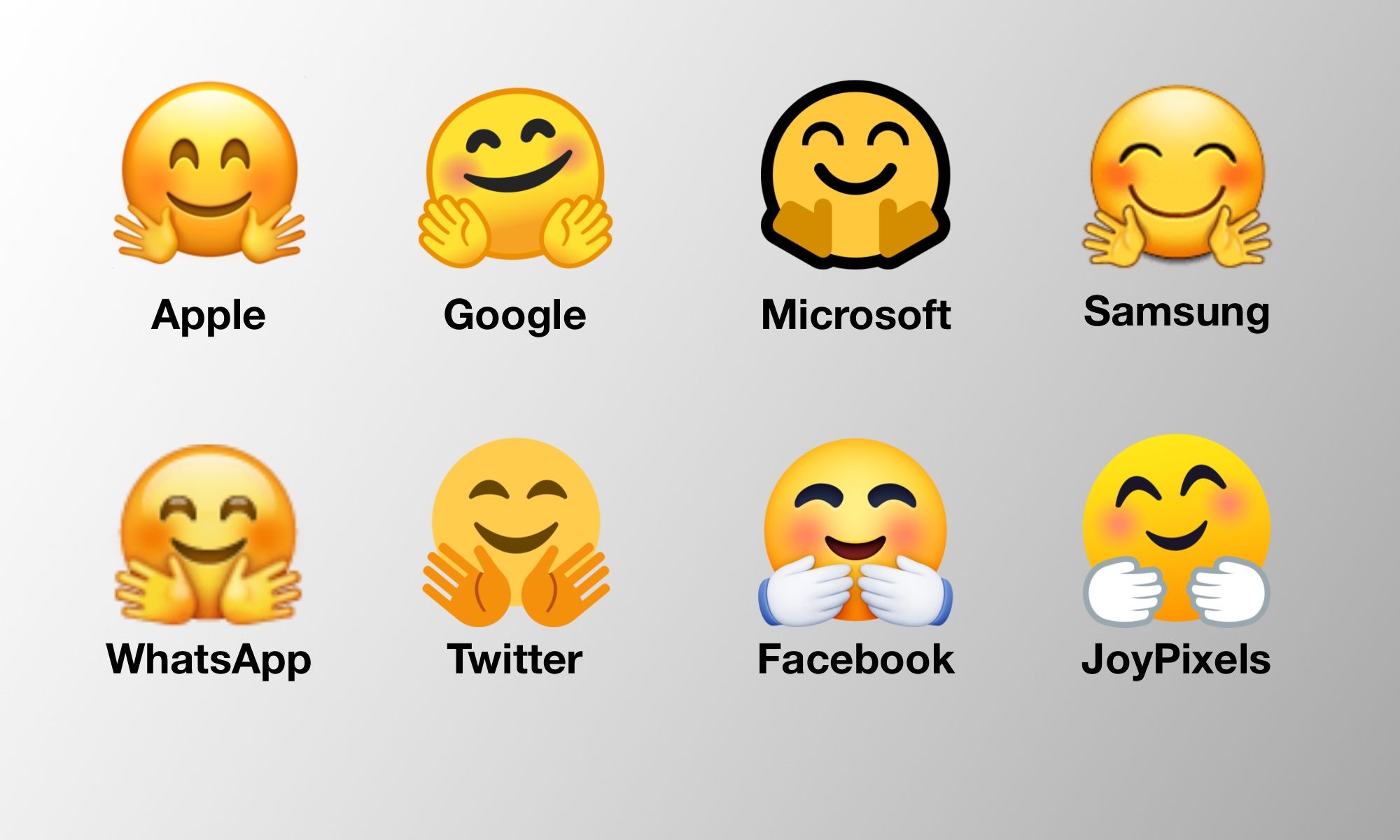
And under its 2.0 release, Facebook’s hands were reaching out towards the viewer in perspective. Which leads us to a first challenge of 🤗 Hugging Face. Some find the emoji creepy, its hands striking them as more grabby and grope-y than warming and welcoming, and its smile, as a consequence, seeming more leering than disarming— like the witch in the fairy tale “Hansel and Gretel.”
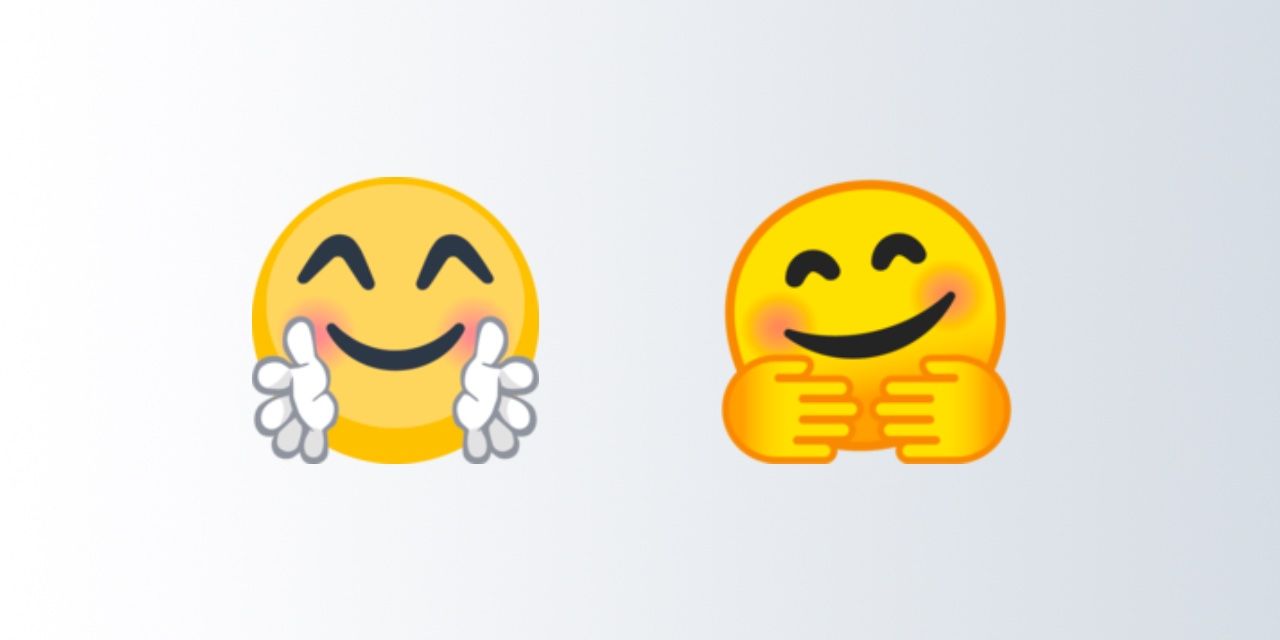
Perhaps people experience a mild, if sometimes joking, unease with 🤗 Hugging Face because there is something uncanny about those hands. In contrast to the emoji’s more cartoon-like face, the hands seem at once too lifelike, as five fingers break with the Western convention of using four fingers in cartoon characters, and too unnatural, both disproportionately small compared to the head and awkwardly positioned.
For others, the appearance and placement of the hands aren’t disturbing. They just don’t look like someone proffering a hug. Which leads us to a second challenge of 🤗 Hugging Face. Many think the emoji is performing jazz hands (also called spirit fingers), a gesture in musical theater where the hands are held, often at the sides, with palms facing forward and fingers splayed, typically waving. The dance move serves as a flourish, and in popular culture, has become a playful or campy way to convey excitement or a sense accomplishment, a gestural “Ta-da!” or “Voila!”
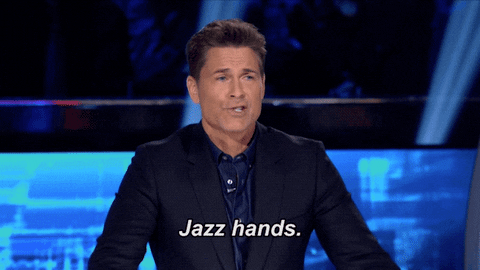
From its debut in 2015 to today, people—including the likes of Elon Musk as recently as 2018—have interpreted 🤗 Hugging Face as jazz hands.
I just realized there is a jazz hands emoji 🤗
— Elon Musk (@elonmusk) March 7, 2018
Musk even discovered that Apple devices suggest 🤗 Hugging Face when you type jazz hands on its keyboards.
Literally, if you type “jazz hands”, iOS shows this emoji 🤗
— Elon Musk (@elonmusk) March 7, 2018
✅ Examples
🤗 Hugging Face is intended to depict a hug, and many do indeed use it to indicate hugs or the care they show. (This application may likely be influenced by the fact of 🤗 Hugging Face's name, not form.)
YOU deserve only the best of hugs 🤗 pic.twitter.com/UjVdSdyvLm
— SpongeBob (@SpongeBob) June 1, 2018
Remember it’s how you over come these hurdles this week and what you take out of it ❤️. Chin up. You got this I know you do 🤗. It’ll be ok.
— Willett 🌀_🌀 🖖🖖 (@Thewillett95) September 21, 2017
By extension, 🤗 Hugging Face is occasionally used to represent the concept of support or acceptance more generally, e.g., "embracing" a new idea.
Success on @Twitch is for YOU to define, not others.
— Cohh Carnage (@CohhCarnage) July 14, 2019
Most casters don't "explode" into success. They may never breach 500 daily viewers. Yet they responsibly support themselves and entertain thousands of people weekly. This is AWESOME!
That IS success and should be embraced! 🤗
While a considerable number may find 🤗 Hugging Face’s appearance creepy, the emoji isn’t widely used to be creepy. Perceived creepiness tends to surface in discussions of the emoji as an emoji.
Help settle an argument?
— Paul Mackay (@plmcky) January 14, 2019
This little guy 🤗: Creepy or no?
By and large, 🤗 Hugging Face is used to express to a wide array of positive sentiments—praise, admiration, gratitude, joy, contentment, excitement—more in line with the enthusiasm of jazz hands, a sort of 🙌 Raising Hands with a smiling face.
It's okay to feel stuck every once in a while, just don't let it control your life. You're in charge of your own destiny. Take a breath and work through it. 🤗 ❣️✨
— Queer Eye (@QueerEye) March 18, 2018
🗒️ Usage
So, the distinctive hands of 🤗 Hugging Face don’t suggest a hug to many users. That's why People Hugging Emoji is a candidate for inclusion in Unicode 13.0. In her proposal for it, Jennifer Daniel, creative director of Google's emoji program, explains:
Hugs aren’t always happy hugs, sometimes they are meant to offer comfort and the existing HUGGING FACE emoji would be wholly inappropriate to send when engaged in a “heavy” conversation ... The intent of this emoji is to convey the intimacy, nuance, and affection that only being hugged or hugging someone can articulate. A singular figure cannot express the sentiment effectively and the proposed TWO PEOPLE HUGGING emoji includes two figures in a warm embrace ... the “🤗” emoji is wholly insufficient in communicating the feeling of a hug and has come to be known as “jazz hands.”
A People Hugging Emoji might fill the gap of a consoling hug left by 🤗 Hugging Face in emojidom—and that’s OK. Because 🤗 Hugging Face, though its name may not match its popular usage, fills a different gap: the need to express a sunny, hands-in-the-air "Yay!" of a, well, \(^-^)/character.
Ambiguity in an emoji’s meaning can create confusion, to be sure, but that’s not always a liability. Because ambiguity, as we see in the interpretation of 🤗 Hugging Face as jazz hands, also leads to creativity. 🤗
